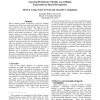127 search results - page 15 / 26 » PCA-Based Speech Enhancement for Distorted Speech Recognitio... |
79
Voted
ICASSP
2011
IEEE
14 years 3 months ago
2011
IEEE
In this paper, we revisit the noise-reduction problem in the time domain and present a way to decompose the ltered speech into two uncorrelated (orthogonal) components: the desire...
100
click to vote
ISCAS
2006
IEEE
15 years 5 months ago
2006
IEEE
Abstract—We present a silicon neuron with a dynamic, active leak that enables precise spike-timing with respect to a time-varying input signal. Our neuron models the mammalian bu...
122
click to vote
IJCAI
1989
15 years 29 days ago
1989
entional user behavior, we need a principled mannerAbstract for relaxing contextual constraints when they are violated.When computer speech recognition is used for problem In order...
ICMCS
2005
IEEE
15 years 5 months ago
2005
IEEE
Close-talk headset microphones have been traditionally used for speech acquisition in a number of applications, as they naturally provide a higher signal-to-noise ratio -needed fo...
ICASSP
2010
IEEE
15 years 19 min ago
2010
IEEE
We propose a novel, robust estimator for the probability of speech presence at each time-frequency point in the short-time discrete Fourier domain. While existing estimators perfo...

